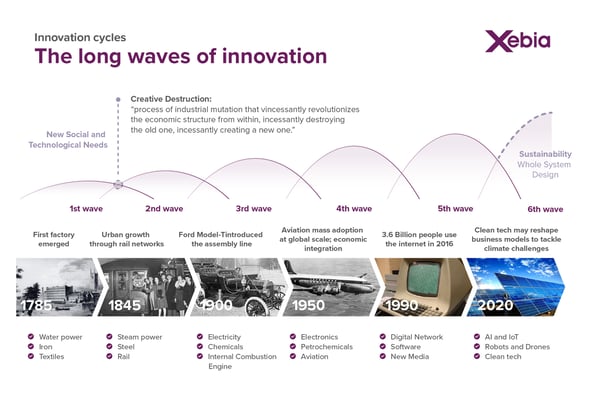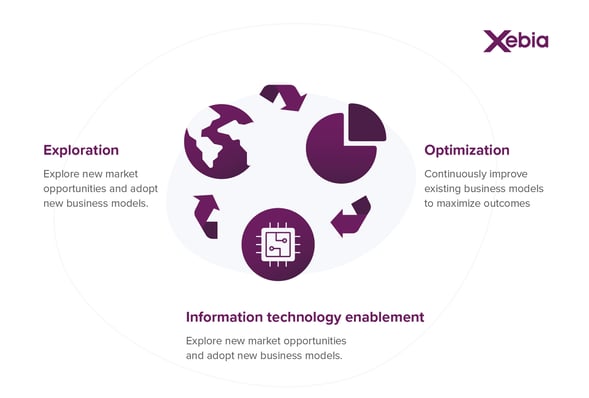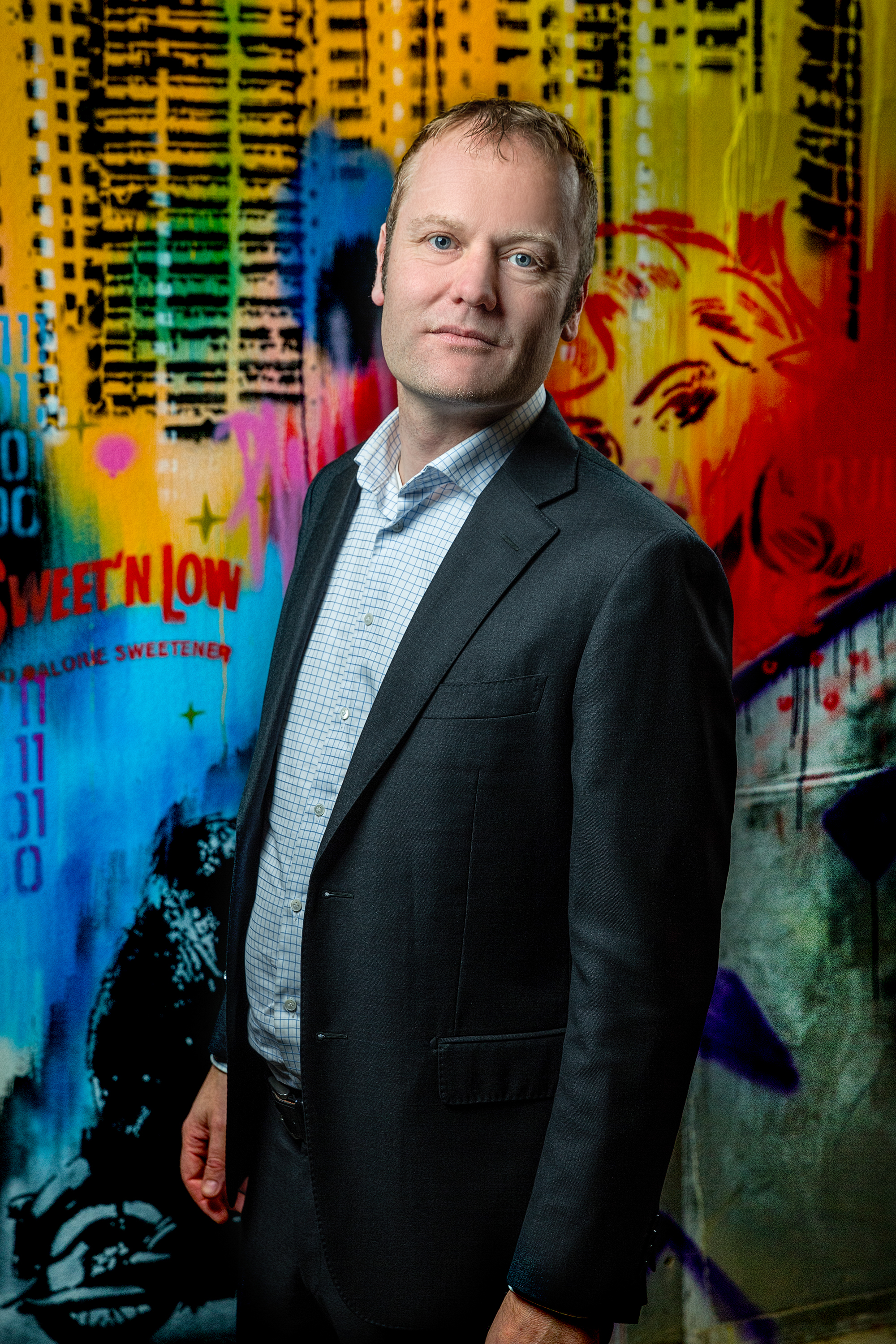About 250 years ago, the first factories opened their doors, marking the beginning of the Industrial Revolution. Five other major transformational periods, also known as ‘waves of innovation,’ followed. Today we are on the eve of the sixth wave: sustainability. What is the driving force behind this wave and what implications will it have for business?
The Driving Force Behind Significant Change
When we talk about ever-changing market environments, what do we mean? What causes these shifts, and what is accelerating them?
The answer is technological and social needs.
On the one hand, we see rapidly evolving technologies like artificial intelligence (AI) and robotics. On the other hand, our world must respond to environmental and social challenges like climate change, population growth, and threats to peace and political justice.
Together, these needs are bringing about profound and mutually reinforcing changes.

Long Waves of Innovation
To understand the dynamics and forces currently at play at global, regional, and local levels, we use "innovation cycles" and "long waves of innovation."
The dynamic interaction between technological advances and changing societal needs creates waves of innovation.
But innovation can cause turmoil. It introduces new structures and types of successful organizations while destroying old ones. Similarly, innovation can cause friction between old and new paradigms, fueling geopolitical events.
The waves of innovation overlap; there are peaks when new paradigms take the upper hand while old ones still exist or even dominate. But eventually, they'll lead to new paradigms and (economic) structures.
Innovation Waves Create Ample Growth Opportunities
"Technical advancements change our lives and how we see business and society."
The driving force behind the latest wave ("the sixth wave of innovation") is society's need for sustainability. More than an action against climate change, it's about improving the quality of life for humanity, all species, and the planet itself. This movement profoundly affects how we view the world, markets, and industries.
Instead of seeing ourselves as controllers of the planet, and our planet as a source of raw materials for economic growth, we are exploring our role in a complex, chaotic, and ever-evolving system.
Technological advances have given us an even better understanding of this system, resulting in more sustainable paradigms, structures, and solutions. Examples include:
Connectedness: Digitization and automation allow us to share enormous amounts of data anytime, anywhere, and at high speed.
Artificial Intelligence: Because we can collect data much faster, we have lots of it. AI helps make the data valuable to us, making it an enabler for innovation.
What Is Success?
The definition of a successful organization is changing. Where we used to look at market value, share price performance, and profits, purpose and corporate social responsibility is now becoming increasingly important. As a result, organizations must look beyond financial results and become sustainable companies.
"A sustainable company will simultaneously generate economic, social, and environmental benefits that lead to competitive advantage and imaginable innovation. It will contribute to an economy that supports a planet where businesses, humankind, and nature can coexist and grow."
But how do you develop a business model that integrates social, cultural, organizational, and technological change to better use resources? The implications for sustainable organizations go beyond existing structures.

Explore the New While Perfecting the Known
Organizations based on topologies that fit earlier waves might only survive the sixth wave of innovation if they can adapt to change — embrace innovations that strengthen their existing business and, at the same time, enable them to explore new business models and market opportunities.
But this is easier said than done. Changes of this size require organizations to obtain, assimilate and use new knowledge and let go of old and established systems. Doing so in a chaotic and complex environment is incredibly challenging.
"Our world is increasingly becoming more unpredictable due to constantly emerging and evolving complex systems that are, by nature, uncontrollable. Add to that the ever-growing use of IT, and you'll have a good idea of today's organizations' challenges."
Challenges for IT, Operations, and Management
Exploring new business models and improving existing ones can lead to the launch of many conflicting initiatives. IT departments are known to spend time on disparate issues rather than focusing their efforts on transformation outcomes that converge towards the change needed to flourish on the sixth wave of innovation.
Organizations need to balance:
- Business innovation initiatives: introduce new systems, processes, and capabilities or replace existing ones.
- Increased innovativeness: optimize innovation capability, time-to-market, and ability to respond to market dynamics.
- Ongoing Feature Demand: the constant need to deliver features piled up in (multi-year) backlogs.
- Application Modernization: modernize and rationalize the application landscape and architecture.
- Cloud transformation: optimize IT by adopting cloud services and specific adoption patterns.
- Operational Excellence: perfect your current operations and continuously improve performance, which includes reliability (SRE).
- Digitization: achieve higher levels of automated processing.
What implications does this have for the IT department?
- The IT department will struggle to keep up with changing customer expectations.
- Margins may come under pressure when organizations do not manage their innovation budget. For example, if existing IT systems require a sudden financial investment or cloud expenses are not controlled and continue to rise.
- IT landscape stability can become a downward spiral: unstable system behavior results in compromised service levels. Advanced and expensive tuning is needed to keep performance levels.
- The organization's inability to scale new business models, channels, or resources can prevent business growth.
- If the existing value chain does not allow for adopting emerging technologies and practices, the cost of change will increase while time-to-market and throughput slow down.
- Implementing change becomes unpredictable: dependencies between teams and IT systems make delivery more complex and generate unexpected integration issues.
New Operating Concepts
As a natural response to the forces of the sixth wave of innovation, new operating concepts are appearing, such as:
- People-centric operations
Collaborative learning, behavioral change, and personal growth nurtured throughout the organization
- Distributed network operations
Purposeful, intelligent sociotechnical systems collaborate to optimize and innovate within a distributed network.
- Engineered, data-driven operations
Optimize flow, insights, and technical agility through hyper-automation and composable technology systems.
Together, these concepts drive innovation and sustainability and strengthen our human capability to create. By looking at people, organization, and technology as one union, we can continuously perfect existing- and explore new business models for a more sustainable future.
https://xebia.com/digital-transformation/digital-strategy/





